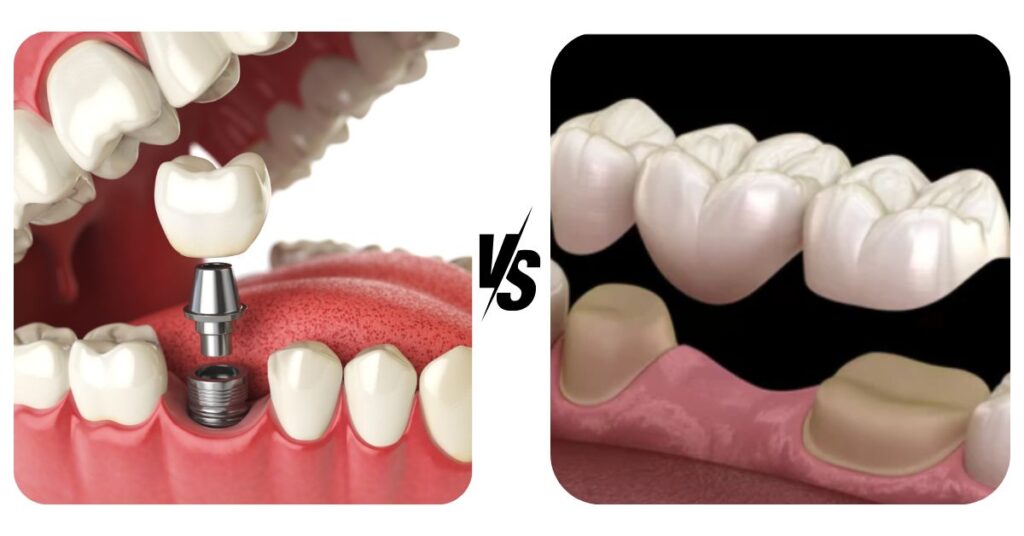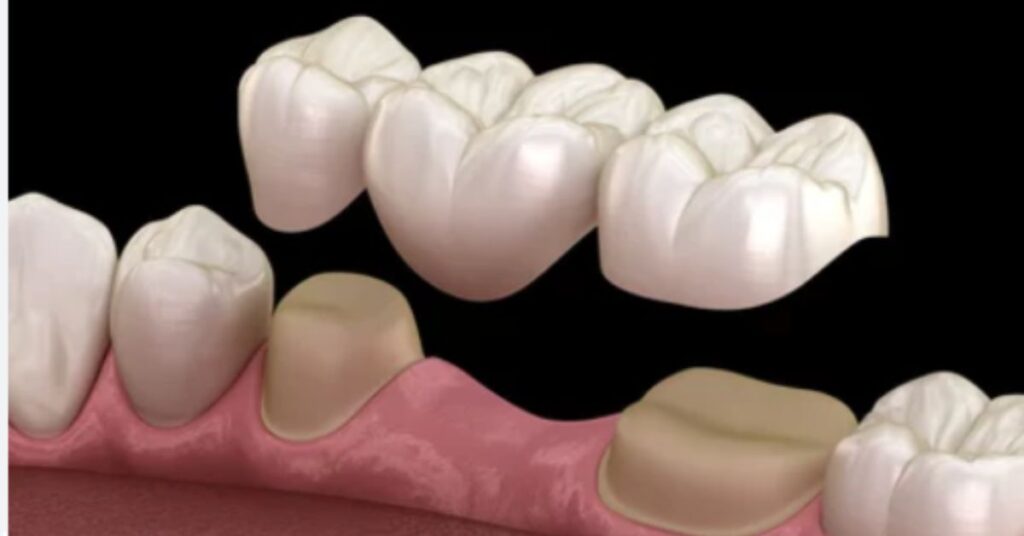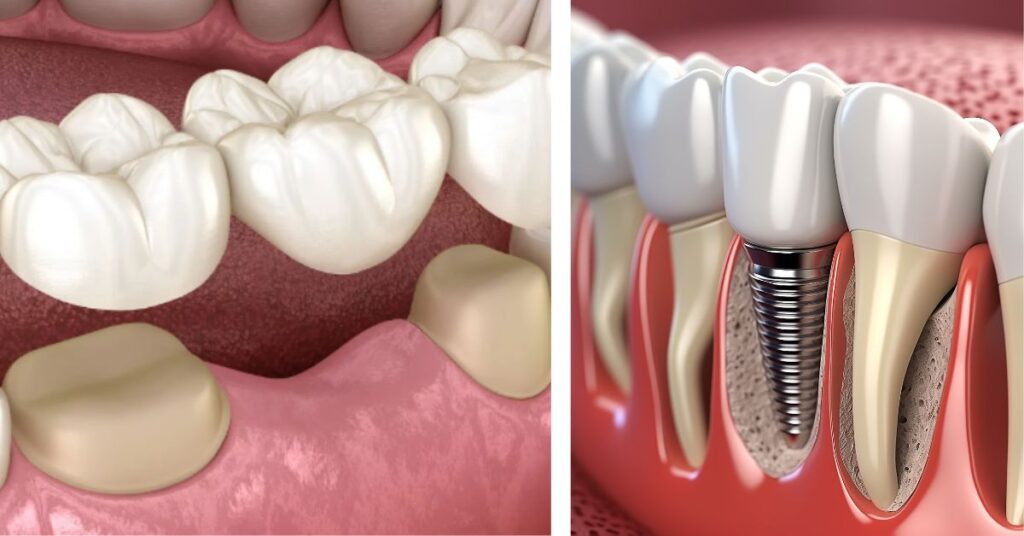
Introduction
The Importance of Replacing Missing Teeth
Losing a tooth can be a traumatic experience, both physically and emotionally. It’s not just about the gaps in your smile – it can also impact your ability to speak, chew, and even your overall confidence. The good news is, modern dentistry offers several solutions to restore your pearly whites, and the two most popular options are dental bridges and dental implants.
Dental Bridge vs Implant: An Overview
When it comes to replacing missing teeth, dental bridges and implants are the two main contenders. A dental bridge is a prosthetic tooth (or teeth) that literally “bridges” the gap left by a missing tooth. It’s anchored to your natural teeth on either side of the gap, providing a secure and natural-looking replacement.
On the other hand, a dental implant is a artificial tooth root that’s surgically implanted into your jawbone. Once the implant has fused with your jawbone (a process called osseointegration), a custom-made crown is attached to the implant, completing the restoration.
Both options have their pros and cons, and the best choice for you will depend on your individual circumstances, budget, and personal preferences.
Understanding Dental Bridges

What Is a Dental Bridge?
A dental bridge is a fixed prosthetic device that spans the gap left by a missing tooth (or teeth). It consists of two main components: the pontics (the artificial teeth that fill the gap) and the abutments (the crowns that are attached to your natural teeth on either side of the gap).
There are several types of dental bridges, each with their own unique advantages and disadvantages:
- Traditional Bridge: This is the most common type of bridge, consisting of pontics held in place by abutments on either side. It’s a reliable and cost-effective option, but it does require your natural teeth to be reshaped to accommodate the abutments.
- Cantilever Bridge: A cantilever bridge is similar to a traditional bridge, but it’s anchored on only one side. This makes it a good choice if you only have one natural tooth remaining on one side of the gap.
- Maryland Bridge: This type of bridge uses metal or ceramic “wings” on the back of the abutment teeth, eliminating the need to reshape your natural teeth.
- Implant-Supported Bridge: As the name suggests, this type of bridge is supported by dental implants rather than your natural teeth. It’s an excellent option if you’re missing multiple teeth or have insufficient natural teeth to support a traditional bridge.
The Pros and Cons of Dental Bridges
Like any dental restoration, dental bridges have their advantages and disadvantages. Here are some of the key pros and cons to consider:
Pros:
- Cost-Effective: Compared to dental implants, bridges are generally more affordable, especially for replacing a single missing tooth.
- Quick Treatment: Getting a dental bridge typically requires just two visits to your dentist, making it a relatively fast solution.
- Natural Appearance: High-quality dental bridges are designed to blend seamlessly with your natural teeth, restoring your smile’s aesthetics.
Cons:
- Potential Damage to Abutment Teeth: Traditional bridges require your natural teeth to be reshaped, which can increase their risk of decay or fracture over time.
- Shorter Lifespan: While well-maintained bridges can last up to 15 years, they will eventually need to be replaced.
- Difficulty Cleaning: Proper oral hygiene around a dental bridge can be challenging, increasing the risk of tooth decay and gum disease if not cleaned properly.
The Dental Bridge Procedure
Getting a dental bridge typically involves the following steps:
- Consultation and Planning: Your dentist will examine your teeth, take X-rays, and discuss your options to determine the best type of bridge for your needs.
- Tooth Preparation: For traditional bridges, your abutment teeth will be reshaped to accommodate the crowns that will anchor the bridge.
- Impressions and Shade Matching: Your dentist will take impressions of your teeth to create a model for the bridge, and will also match the shade of the pontics to your natural teeth.
- Temporary Bridge Placement: A temporary bridge may be placed to protect your teeth and allow you to eat and speak comfortably while your permanent bridge is being fabricated.
- Permanent Bridge Placement: Once your custom bridge is ready, your dentist will remove the temporary bridge and cement the permanent one in place, ensuring a secure and comfortable fit.
- Follow-Up Care: Your dentist will provide instructions on how to properly care for your new dental bridge, including tips on flossing, brushing, and avoiding foods that could damage or dislodge the bridge.
Understanding Dental Implants

What Are Dental Implants?
Dental implants are a revolutionary solution for missing teeth that have become increasingly popular in recent years. Unlike dental bridges, which rely on your natural teeth for support, implants are stand-alone artificial tooth roots that are surgically implanted into your jawbone.
A dental implant consists of three main components:
- The Implant Fixture: This is the titanium post that’s inserted into your jawbone during the surgical procedure. It’s designed to fuse with your bone over time, providing a strong and sturdy foundation for the replacement tooth.
- The Abutment: This is a connector piece that attaches the implant fixture to the crown (the visible part of the tooth).
- The Crown: This is a custom-made, tooth-colored restoration that’s designed to match the shape, size, and color of your natural teeth.
Once the implant has fused with your jawbone (a process called osseointegration), the abutment and crown are attached, creating a functional and natural-looking replacement tooth that’s virtually indistinguishable from your real teeth.
The Pros and Cons of Dental Implants
Dental implants are often considered the gold standard for tooth replacement, but they do have their pros and cons:
Pros:
- Unparalleled Stability: Implants are securely anchored in your jawbone, providing exceptional stability and enabling you to eat, speak, and smile with confidence.
- Preserves Bone Density: Unlike bridges, which can contribute to bone loss over time, implants stimulate bone growth and help preserve your natural jawbone structure.
- Long-Lasting Solution: With proper care and maintenance, dental implants can last a lifetime, making them a wise investment in your oral health.
Cons:
- Higher Initial Cost: Dental implants are generally more expensive than bridges, especially if you need multiple implants or additional procedures like bone grafting.
- Longer Treatment Time: The implant process can take several months to complete, as your jawbone needs time to heal and fuse with the implant fixture.
- Potential Complications: As with any surgical procedure, there are risks of complications like infection, nerve damage, or implant failure, though these are relatively rare when performed by a skilled implant dentist.
The Dental Implant Procedure
Getting dental implants is a multi-step process that typically involves the following stages:
- Consultation and Planning: Your dentist will evaluate your oral health, take X-rays and 3D scans, and discuss your treatment goals to determine if you’re a suitable candidate for implants.
- Preparatory Procedures (if needed): Depending on your individual case, you may need procedures like bone grafting or sinus lifts to ensure sufficient bone density and volume for successful implant placement.
- Implant Surgery: During this outpatient procedure, your dentist will surgically place the implant fixture(s) into your jawbone. You’ll be given local anesthesia to ensure your comfort throughout the process.
- Osseointegration: This is the healing period (typically 3-6 months) during which your jawbone fuses with the implant fixture, providing a solid foundation for the replacement tooth.
- Abutment Placement: Once osseointegration is complete, your dentist will attach the abutment to the implant fixture, creating a secure connection point for the crown.
- Crown Placement: After taking impressions and matching the shade, your dentist will attach the custom-made crown to the abutment, completing your new, natural-looking tooth
Factors to Consider When Choosing Between Dental Bridges and Implants

Oral Health and Jawbone Condition
One of the most crucial factors in determining whether you’re a better candidate for dental bridges or implants is your overall oral health and jawbone condition. For dental implants to be successful, you need sufficient healthy jawbone density to support the implant fixtures.
If you’ve experienced significant bone loss due to gum disease, injury, or extended periods with missing teeth, you may not have enough bone volume for implants. In these cases, your dentist may recommend a bone grafting procedure to rebuild the jawbone before implant placement.
Additionally, certain medical conditions like uncontrolled diabetes or autoimmune disorders can impact your body’s ability to heal properly after implant surgery, increasing the risk of implant failure. Your dentist will carefully evaluate your medical history and overall health to determine if implants are a viable option.
On the other hand, dental bridges don’t require the same level of jawbone density, making them a more accessible solution for many patients, especially those with advanced bone loss or certain health conditions that preclude implant surgery.
Cost and Insurance Coverage
Cost is often a significant factor when considering dental bridges vs. implants. While both options involve significant upfront expenses, the long-term costs can vary considerably.
Dental implants, on the other hand, are more expensive up front, with costs ranging from $3,000 to $6,000 per implant (including the implant fixture, abutment, and crown). However, implants are designed to be a permanent solution, lasting decades (or even a lifetime) with proper care and maintenance.
It’s important to note that dental insurance policies vary widely in their coverage for bridges and implants. Many plans may cover a portion of the costs for bridges, but implant coverage is less common. Be sure to check with your insurance provider and factor in any out-of-pocket expenses when weighing your options.
Longevity and Maintenance Requirements
The longevity of dental bridges and implants can differ significantly, and this is an important consideration when weighing the long-term costs and convenience of each option.
Well-maintained dental bridges can last anywhere from 5 to 15 years, with the average lifespan being around 10 years. However, their longevity depends on several factors, including the materials used, the quality of the workmanship, and your oral hygiene habits.
Dental implants, on the other hand, are designed to be a permanent solution, with many implants lasting 20 years or more with proper care. The implant fixture itself (the titanium post embedded in your jawbone) can effectively last a lifetime, though the crown may need to be replaced every 10-15 years due to normal wear and tear.
In terms of maintenance, both bridges and implants require diligent oral hygiene practices, including regular brushing, flossing, and professional cleanings. However, dental implants are generally easier to keep clean, as they don’t have the crevices and spaces that can trap food and bacteria like bridges do.
Ultimately, the longevity and maintenance requirements of each option should be carefully weighed against the upfront and long-term costs to determine the most cost-effective solution for your individual needs and budget.
Making an Informed Decision
Consulting with a Dental Professional
Choosing between dental bridges and implants is a highly personal decision that should be made in close consultation with a qualified dental professional. Your dentist or prosthodontist (a specialist in tooth replacement and restoration) will be able to evaluate your specific needs, oral health condition, and lifestyle factors to recommend the most suitable option.
During your consultation, be sure to ask plenty of questions and voice any concerns you may have about the procedures, risks, recovery times, and long-term maintenance requirements. A good dental professional will take the time to thoroughly explain each option, address your concerns, and help you make an informed decision that aligns with your goals and preferences.
It’s also important to feel comfortable with the dentist or specialist you choose, as you’ll be establishing a long-term relationship with them for the placement, maintenance, and potential future replacement of your dental restoration.
Considering Long-Term Goals and Lifestyle
In addition to your oral health and financial considerations, it’s also important to factor in your long-term goals and lifestyle preferences when choosing between dental bridges and implants.
For example, if you’re younger and want a permanent, low-maintenance solution that can potentially last a lifetime, dental implants may be the better choice, despite the higher upfront costs. Alternatively, if you’re older or have a limited budget, a dental bridge may be a more suitable short-term solution.
Your lifestyle habits can also play a role in the decision-making process. If you have a history of teeth grinding (bruxism) or clenching, dental implants may be the more durable option, as they’re less likely to be damaged or dislodged by excessive force. Similarly, if you have a physically demanding job or participate in high-impact sports, the added stability of implants could be beneficial.
Ultimately, the choice between dental bridges and implants should be based on a careful consideration of your individual circumstances, goals, and lifestyle preferences, in addition to the clinical recommendations of your dental professional.
Chapter 6. FAQs
6.1. FAQs About Dental Bridges
How long do dental bridges last? The average lifespan of a dental bridge is 5-15 years, with proper care and maintenance. However, factors like the materials used, quality of workmanship, and your oral hygiene habits can impact its longevity.
Can dental bridges be repaired or replaced? Yes, dental bridges can be repaired or replaced if they become damaged or worn down over time. However, replacement may involve additional costs and procedures.
How to care for dental bridges? Proper care for dental bridges involves diligent oral hygiene practices, including brushing twice daily, flossing (using specialized floss threaders for bridges), and attending regular professional cleanings. Avoiding hard, sticky, or crunchy foods can also help extend the life of your bridge.
What are the potential risks or complications of dental bridges? Potential risks and complications of dental bridges include tooth decay or gum disease (if not cleaned properly), damage or fracture to the abutment teeth, and loosening or dislodging of the bridge over time.
Conclusion
Replacing missing teeth is crucial for maintaining proper oral function, preserving your facial structure, and boosting your confidence with a complete, natural-looking smile. While dental bridges and implants are both effective solutions, they differ significantly in terms of their design, procedure, durability, and cost.
Dental bridges are a more affordable and faster solution, but they have a shorter lifespan and may require periodic replacement. They also rely on your natural teeth for support, which can increase the risk of further tooth decay or damage over time.
On the other hand, dental implants are a more permanent and low-maintenance solution, designed to last a lifetime with proper care. However, they involve a more invasive and lengthy process, higher upfront costs, and potential surgical risks.
